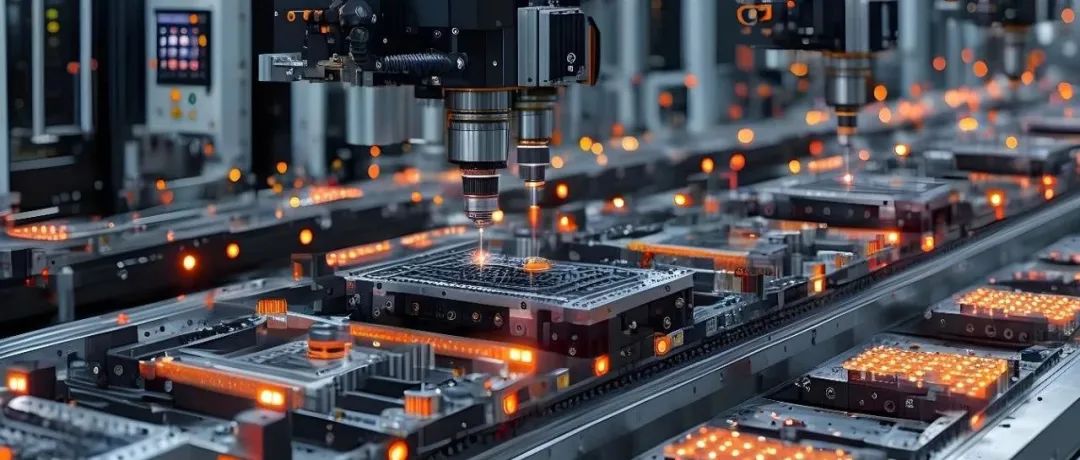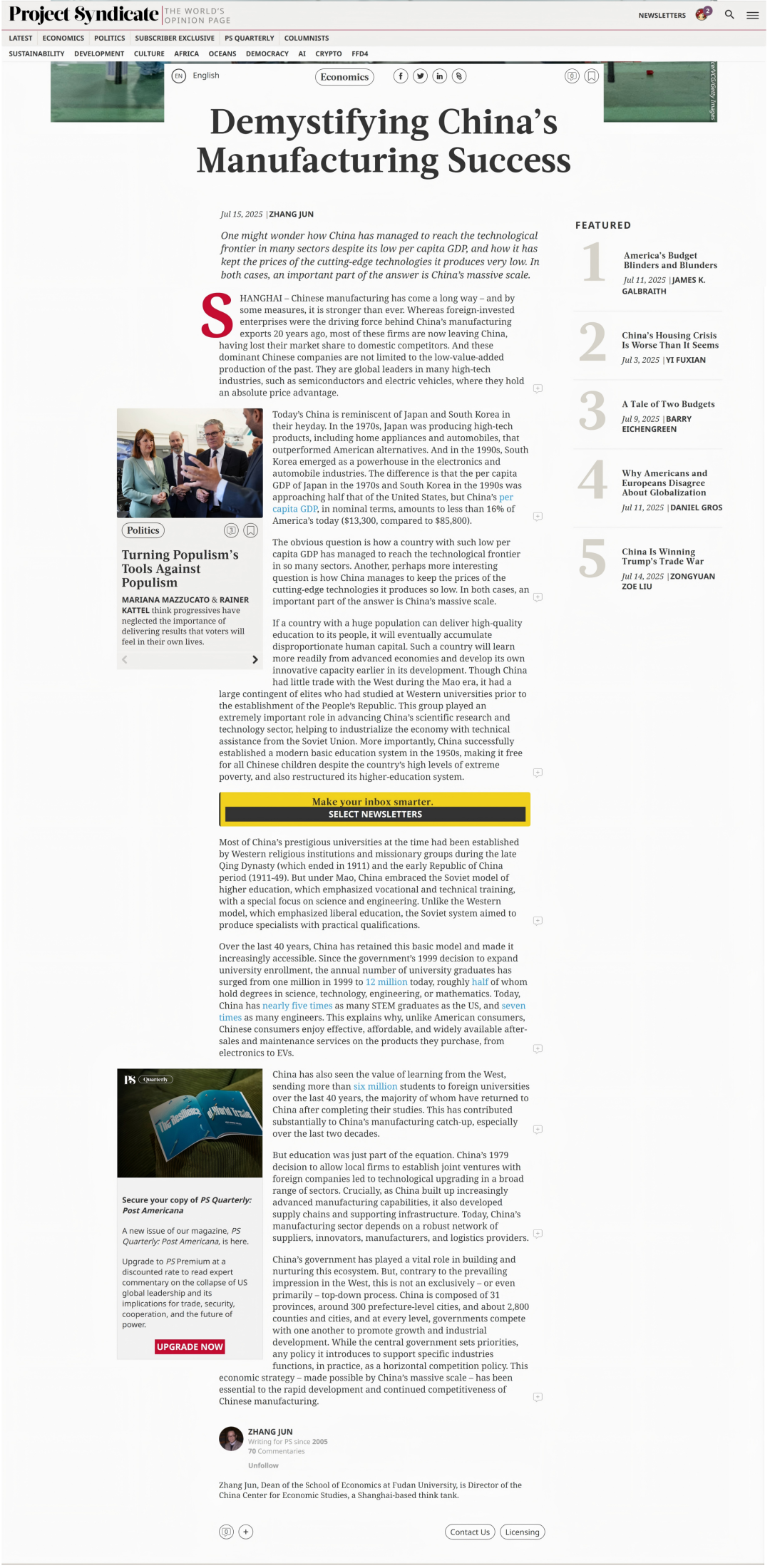作者:张军 发布时间:2025-07-20 来源:Project Syndicate+收藏本文

你可能好奇,尽管人均GDP还那么低,中国为什么能在很多领域达到技术的前沿?它怎么能把它所生产的一流技术产品的价格做到这么低?无论如何,中国的超级规模是一个重要的答案。
7月15日,复旦大学文科资深教授、经济学院院长、中国经济研究中心主任张军教授在 Project Syndicate 发表深度分析文章Demystifying China’s Manufacturing Success。全文发表于 Project Syndicate,我们推送中文翻译版,并转发英文原文,以飨读者。
中国的制造业取得了长足的进步,而且某种意义上说它确实比任何时候都强大。20年前外资企业依然还是中国制造品出口的主力军,今天他们多数都要撤离中国,将市场份额拱手相让中国的本土竞争者。而这些中国企业不再仅仅是低端产品的生产者,已成为在诸如半导体、电动车等很多高科技领域的全球领袖,而在这些领域中国拥有绝对的价格优势。
今天的中国有点像当年最顶峰时期的日本和韩国。日本在上世纪70年代可以制造出打败美国竞争对手的技术复杂产品,包括家用电器和汽车。而在90年代,韩国在汽车和电子行业迅速崛起成为世界工厂。唯一不同的是,无论是70年代的日本还是90年代的韩国,他们那时的人均GDP已接近美国的一半,但中国今天的人均GDP按名义值计算仅为13300美元,还不到美国85800万美元的16%。
显而易见的问题是,收入依然这么低的中国何以能拥有创造前沿技术的超常能力?也可以反过来问,给定中国在制造技术上已经达到的高度,为什么生产的产品可以这么便宜?这两个问题的一个非常主要的答案在于中国的超级规模。
在一个人口规模庞大的国家,它的人口如能享受高水平的教育,最终会积累不成比例的人力资本。而这是它向先进国家学习和实现科技自主创新的能力的来源。中国在毛时代虽然与西方鲜有贸易往来,但它却拥有民国时期大批在西方大学接受教育的留学生队伍,这些回到中国的精英们在促进新中国的科学研究和技术中发挥了重要作用,并在苏联的技术专家支持下,帮助了中国经济的工业化。更重要的是,尽管那时非常贫穷,中国还是迅速推行了平权的现代教育,实行全民免费,同时又仿照苏联模式大规模重组和改造了高等教育体系。
中国现代意义上的著名大学不过百年,多为清末民初由西方教会在中国的主要城市创办,但毛在建国后采纳了苏联模式,而苏联的高等教育更注重细分的专业和理工科精英教育。跟西方注重博雅教育不同,苏联模式以培养更多的技术专业人士为目标。
过去40年中国维持了这个大学教育制度并加快了规模扩张。在1999年中国政府决定扩大高校招生规模之后,每年毕业生规模已从1999年的100万扩大到了如今1200万。这当中有一半来自STEM专业。这个数字几乎是美国的15倍,而中国的工程师规模几乎是美国的9倍。这解释了为什么美国人难以像中国客户那样享受便利而高效的售后与维修服务。
中国也历来看重向西方学习的价值。中国在过去40年向西方的大学派出了600多万留学生,大部分都回到了中国。这些归国留学生为中国制造业的追赶做出了重大贡献,尤其是在过去20年。
但教育只是整个方程的一部分。早在1979年中国就决定允许本土企业与外国公司组建合资企业,这在相当宽广的领域推动了制造业技术的升级。特别关键的是,随着中国开始建立更加复杂的制造能力,中国发展出了强大的供应链和配套的基础设施。事实上,今天中国制造业的强大依靠了一个囊括供应商、技术开发者、制造商和物流的强大网络系统。
中国政府在构建和培育这个生态系统中发挥了关键角色。但是,跟西方长期的印象不同,这并非全然自上而下的过程。中国是由31个省、约300个地级市和2800多个县(市)构成的。在每一个层级,政府之间都是发展制造业的竞争对手。因此,任何针对特定产业的支持政策在实际上都会演变成横向竞争政策。这个经济战略—由中国的超大规模使然—对于推动经济快速发展和中国制造业的持续竞争优势至关重要。
Chinese manufacturing has come a long way – and by some measures, it is stronger than ever. Whereas foreign-invested enterprises were the driving force behind China’s manufacturing exports 20 years ago, most of these firms are now leaving China, having lost their market share to domestic competitors. And these dominant Chinese companies are not limited to the low-value-added production of the past. They are global leaders in many high-tech industries, such as semiconductors and electric vehicles, where they hold an absolute price advantage.
Today’s China is reminiscent of Japan and South Korea in their heyday. In the 1970s, Japan was producing high-tech products, including home appliances and automobiles, that outperformed American alternatives. And in the 1990s, South Korea emerged as a powerhouse in the electronics and automobile industries. The difference is that the per capita GDP of Japan in the 1970s and South Korea in the 1990s was approaching half that of the United States, but China’s per capita GDP, in nominal terms, amounts to less than 16% of America’s today ($13,300, compared to $85,800).
The obvious question is how a country with such low per capita GDP has managed to reach the technological frontier in so many sectors. Another, perhaps more interesting question is how China manages to keep the prices of the cutting-edge technologies it produces so low. In both cases, an important part of the answer is China’s massive scale.
If a country with a huge population can deliver high-quality education to its people, it will eventually accumulate disproportionate human capital. Such a country will learn more readily from advanced economies and develop its own innovative capacity earlier in its development. Though China had little trade with the West during the Mao era, it had a large contingent of elites who had studied at Western universities prior to the establishment of the People’s Republic. This group played an extremely important role in advancing China’s scientific research and technology sector, helping to industrialize the economy with technical assistance from the Soviet Union. More importantly, China successfully established a modern basic education system in the 1950s, making it free for all Chinese children despite the country’s high levels of extreme poverty, and also restructured its higher-education system.
Most of China’s prestigious universities at the time had been established by Western religious institutions and missionary groups during the late Qing Dynasty (which ended in 1911) and the early Republic of China period (1911-49). But under Mao, China embraced the Soviet model of higher education, which emphasized vocational and technical training, with a special focus on science and engineering. Unlike the Western model, which emphasized liberal education, the Soviet system aimed to produce specialists with practical qualifications.
Over the last 40 years, China has retained this basic model and made it increasingly accessible. Since the government’s 1999 decision to expand university enrollment, the annual number of university graduates has surged from one million in 1999 to 12 million today, roughly half of whom hold degrees in science, technology, engineering, or mathematics. Today, China has nearly five times as many STEM graduates as the US, and seven times as many engineers. This explains why, unlike American consumers, Chinese consumers enjoy effective, affordable, and widely available after-sales and maintenance services on the products they purchase, from electronics to EVs.
China has also seen the value of learning from the West, sending more than six million students to foreign universities over the last 40 years, the majority of whom have returned to China after completing their studies. This has contributed substantially to China’s manufacturing catch-up, especially over the last two decades.
But education was just part of the equation. China’s 1979 decision to allow local firms to establish joint ventures with foreign companies led to technological upgrading in a broad range of sectors. Crucially, as China built up increasingly advanced manufacturing capabilities, it also developed supply chains and supporting infrastructure. Today, China’s manufacturing sector depends on a robust network of suppliers, innovators, manufacturers, and logistics providers.
China’s government has played a vital role in building and nurturing this ecosystem. But, contrary to the prevailing impression in the West, this is not an exclusively – or even primarily – top-down process. China is composed of 31 provinces, around 300 prefecture-level cities, and about 2,800 counties and cities, and at every level, governments compete with one another to promote growth and industrial development. While the central government sets priorities, any policy it introduces to support specific industries functions, in practice, as a horizontal competition policy. This economic strategy – made possible by China’s massive scale – has been essential to the rapid development and continued competitiveness of Chinese manufacturing.
以下为英文原版文章网页
